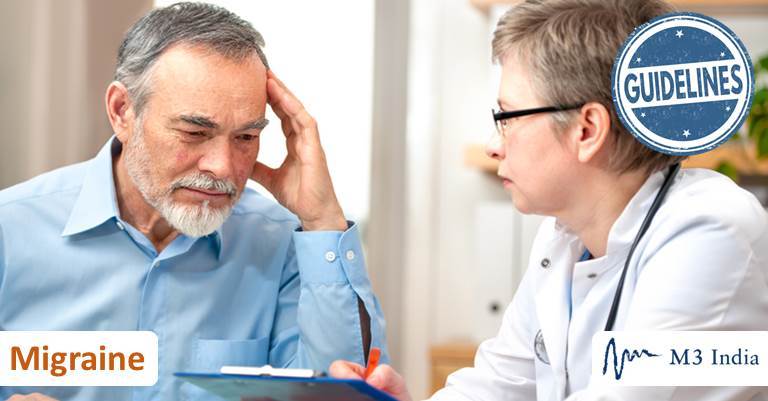2019 Migraine prevention and treatment guidelines: American Headache Society
M3 India Newsdesk Apr 01, 2019
Summary
The comprehensive guidelines developed by AAN and American Headache Society cover,
- migraine prophylactic and acute therapy
- recommendations for episodic prevention in adults
- advice on NSAIDs usage and complementary treatment options

The American Headache Society (AHS) has recently updated its migraine prevention and acute treatment guidelines in 2019. Treating migraine not only involves steps that lessen migraine triggers, but in people that have regular attacks, treatment includes acute or abortive therapy, and also prophylactic or preventive therapy.
American Headache Society preventive migraine treatment guidelines
Preventive treatment is given to lessen the frequency and severity of the migraine attack when there is no headache present. The guidelines suggest the treatment for:
- Anyone that has 4 or more migraine attacks per month and/or if their normal functioning and daily routine is being negatively affected by the migraine attacks even after acute treatment
- In patients, if there is overuse, frequent failure, intolerable adverse effects, or contraindications to acute treatment
Medications include oral therapy with antiepileptic drugs (AEDs), beta blockers, tricyclic antidepressants, calcium channel blockers, selective serotonin reuptake inhibitors (SSRIs), NSAIDs, serotonin antagonists, botulinum toxin, and calcitonin gene-related peptide (CGRP) inhibitors. Preventive therapy also makes it more likely that when the attack occurs, it is more responsive to abortive therapy and also betters the patient's quality of life.
Precautions
- Anti-epileptics like valproate sodium and topiramate should not be prescribed to women who can conceive, and to those not using birth control.
- Adverse effects of migraine drugs may occur during treatment and therefore oral treatment should be started at a low dose and the dosages should be slowly increased over at least a minimum of 8 weeks for optimal therapeutic result.
AHS acute migraine treatment guidelines
Abortive or acute therapy mediation involves selective serotonin receptor (5-HT1) agonists (triptans), ergot alkaloids, analgesics, nonsteroidal anti-inflammatory drugs (NSAIDs), combination products and antiemetics. It is given after the headache has started with an aim to reduce or stop the headache.
- At the earliest sign of a migraine attack, evidence-based treatment should be initiated.
- Mild to moderate attacks should be treated with NSAIDs (including aspirin), nonopioid analgesics, acetaminophen, or caffeinated analgesic combinations.
- Mild to moderate attacks that poorly respond to NSAIDs or caffeinated combinations and moderate or severe attacks should be treated with migraine‐specific agents such as triptans and dihydroergotamine.
- In patients experiencing nausea or vomiting, or difficulty in swallowing, a non-oral route of medication administration should be chosen. SC sumatriptan, DHE injection or intranasal spray, or corticosteroids are possible outpatient rescue options whereas parenteral formulations of triptans, DHE, antiemetics, NSAIDs, anticonvulsants (eg, valproate sodium and topiramate, except in women of childbearing age who are not using reliable birth control), corticosteroids, and magnesium sulfate are possible inpatient rescue options.
Episodic migraine prevention in adults
The American Academy of Neurology and the American Headache Society, have put forward pharmacologic treatment guidelines for episodic migraine prevention in adults.
- Level A recommendations; effective medicines that should be offered for migraine prevention include,
- antiepileptic drugs (AEDs) such as divalproex sodium, sodium valproate and topiramate
- triptans such as frovatriptan for preventing menstrually associated migraine (MAM)
- β-Blockers such as metoprolol, propranolol and timolol
- Level B recommendations; probably effective and should be considered medications include,
- antidepressants such as amitriptyline, venlafaxine
- β-blockers such as atenolol, nadolol
- triptans such as naratriptan, zolmitriptan for short-term MAM prevention
- Level C recommendations; medications that are possibly effective and may be considered include,
- ACE inhibitors such as lisinopril
- angiotensin receptor blockers such as candesartan
- α-agonists such as clonidine, guanfacine
- AEDs such as carbamazepine
- β-Blockers such as nebivolol, and pindolol
Use of NSAIDs/complementary treatments for episodic migraine prevention in adults
- Level A recommendations (effective and should be offered): Petasites (butterbur)
- Level B recommendations (probably effective and should be considered): NSAIDs such as fenoprofen, ibuprofen, ketoprofen, naproxen, naproxen sodium, herbal therapies, vitamins, and minerals such as riboflavin, magnesium, MIG-99 (feverfew) and histamines SC
- Level C recommendations (possibly effective and may be considered): NSAIDs such as flurbiprofen, mefenamic acid, herbal therapies, vitamins, and minerals: Co-Q10, estrogen and antihistamines such as cyproheptadine
Other therapy considerations
- More than 90% of patients with a headache that goes to the emergency department are found to have migraine, tension, or mixed-type benign headache and giving symptomatic pain relief should be a top priority.
- Keeping the patient in a quiet dark room is beneficial.
- Applying cool compresses to painful areas may also help.
- Pain killers and narcotics are the mainstays of pain relief management but narcotics are mainly ineffective for patients with migraine in the ED.
- If required, patients with migraine should be taken to the emergency department with minimal visual and auditory stimulation and until a thorough neurologic examination has been conducted by a trained specialist, opioids should not be given to most patients.
Migraine triggers
Identifying and avoiding migraine triggers (eg, lack of sleep, fatigue, stress, certain foods, use of vasodilators, OCP, HRT) is an effective cheap alternative that goes a long way in migraine management. Patients with migraine should be screened and actively treated for cardiovascular risk factors.
Patients with migraine and aura should be warned about the greater risk of stroke associated with smoking or taking oral contraceptive pills. If clinically required, a specialist such as a neurologist, neuro-ophthalmologist, and/or neurosurgeon should assist with the management of the patient with migraine.
Hospital admission
Migraine patients may require hospital admission and treatment under these criteria:
- Severe nausea, vomiting, and dehydration
- Severe, refractory migraine pain (i.e. status migrainosus)
- Combination analgesics, ergots, or opioid detoxification after overuse
-
Exclusive Write-ups & Webinars by KOLs
-
Daily Quiz by specialty
-
Paid Market Research Surveys
-
Case discussions, News & Journals' summaries